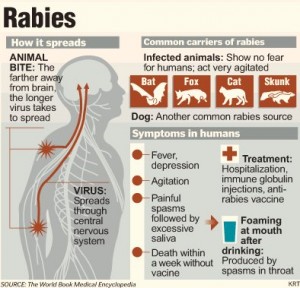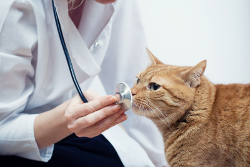There is a very good reason why the word “rabies” ignites feelings of fear and concern. It is a deadly zoonotic disease that attacks the brain and central nervous system (CNS). All mammals are susceptible to it. Once the symptoms of rabies are present in a cat, the disease is nearly 100% fatal. Fortunately for your cat, it is also 100% preventable.
Causes of Rabies
 Rabies is a virus that is most commonly transmitted through a bite from a rabid animal. Infectious particles of the virus are retained in the salivary glands of the carrier to better spread the virus throughout their saliva. In the United States, the primary carriers of rabies in wildlife consist of:
Rabies is a virus that is most commonly transmitted through a bite from a rabid animal. Infectious particles of the virus are retained in the salivary glands of the carrier to better spread the virus throughout their saliva. In the United States, the primary carriers of rabies in wildlife consist of:
- Bats
- Raccoons
- Foxes
- Skunks
Although less common, it can also be transmitted by the exchange of blood and through inhaling the escaping gases from a decomposing animal’s carcass. Contracting the rabies virus this way is rare but cases have occurred. After initial exposure, the virus incubates and it may take anywhere from a few days to a year for any symptoms to become apparent. Once symptoms are exhibited, death usually follows within ten days.
Types of Rabies
There are two different types of rabies: paralytic and furious. In the early (prodromal) stage of infection, there may only be mild signs of central nervous system (CNS) abnormalities. The prodromal stage usually lasts one to three days, after which the infection will enter either the paralytic stage, the furious stage or a combination of both.
Furious rabies
Furious rabies causes symptoms such as extreme behavioral changes including aggression and attack behavior, but other behavioral changes such as being overly affectionate can sometimes be observed as well. This change in behavior occurs because it ideally allows the virus to spread to others.
Paralytic rabies
Paralytic rabies is characterized by symptoms of weakness, loss of coordination, and paralysis.
General Symptoms
It’s important to note that this a very fast acting virus once it becomes active. When symptoms are evident after the incubation period, the prognosis is poor. Some other symptoms of a rabies infection include:
- Aggression
- Hypersalivation or frothy saliva
- Disorientation
- Slack jaw
- Seizures
- Fever
- Paralysis
- Pica
- Hydrophobia
- Trouble swallowing
- Lack of muscular coordination
Here is an example of a cat that has tested positive for Rabies: Note the disorientation and aggression in it’s behavior:
How Rabies is Diagnosed
Unfortunately, there is no test to accurately diagnose the rabies virus in live animals. The direct fluorescent antibody test can only be performed post-mortem and it is the only test that can accurately diagnose the rabies virus. If you have any reason to believe your cat may have come into contact with a rabid animal, do not hesitate to call your veterinarian.
If you can safely get your cat in his carrier or otherwise subdue him and take him into your veterinarian’s office, please do so immediately. If your cat is behaving aggressively or you are at risk of being bitten or scratched, please call animal control and they will safely catch your cat for you.
What Happens if Rabies is Suspected
There is no treatment for rabies in cats. Your veterinarian will quarantine your cat for observation throughout a ten day period. If your cat exhibits progressive signs of a rabies infection, euthanasia will be discussed. Thus far, this is the only acceptable way of dealing with a rabies infection.
It’s All About Prevention
 Fortunately, the contraction of the rabies virus is completely preventable. Kittens should receive their first rabies vaccination at eight to twelve weeks of age and continue a schedule of vaccinations throughout their lives. Most commonly, a cat receives a rabies booster every three years. Cats that are let outside may receive a booster annually. Even if your cat is never let outside, it is the law in a number of states in the US to keep your pet’s rabies vaccinations up to date.
Fortunately, the contraction of the rabies virus is completely preventable. Kittens should receive their first rabies vaccination at eight to twelve weeks of age and continue a schedule of vaccinations throughout their lives. Most commonly, a cat receives a rabies booster every three years. Cats that are let outside may receive a booster annually. Even if your cat is never let outside, it is the law in a number of states in the US to keep your pet’s rabies vaccinations up to date.
Please be aware of the legal time-frame in your state or be aware of similar laws in your own country. This law is only for the protection of your cat and all fellow mammals. The well-being of your cat depends on your dedication to being informed and proactive when it comes to his health. Ask your veterinarian questions and remain updated on the latest medical advances such as parasite prevention and new forms of vaccinations.
Side Effects of the Rabies Vaccine
As with any vaccine, there are possible side effects. In cats, most are mild and only last a few days. The side effects are the result of your cat’s immune system reacting to the introduction of the virus into his system. His system is creating a line of defense to deal with the foreign intrusion and building immunity to it. This is how vaccines work. Some of the most common side effects include:
- Loss of appetite
- Vomiting
- Lethargy
- Diarrhea
- Slight fever
- Swelling and soreness at the injection site
- Sneezing
However slight, there is still potential for serious side effects in some cats.
Anaphylactic Shock
Anaphylactic Shock: This is an allergic reaction. Be alert and watch for difficulty breathing, cold extremities, seizures, facial swelling, or severe G.I. upset. If your cat exhibits any of these symptoms, it is important to get him to your veterinarian immediately.
Vaccine-Associated Fibrosarcomas
Vaccine-Associated Fibrosarcomas: A small percentage of cats may develop a tumor at the vaccination site. It may take anywhere from a few days to over a year after the vaccination is administered for a sarcoma to develop. It usually presents as a subcutaneous (under the skin) lump at the vaccination site.
These rare effects can be life threatening if not promptly treated. If your cat is exhibiting any serious reactions to a rabies vaccination or any other vaccine, please alert your veterinarian immediately.
Thanks for visiting www.catdandruffclinic.com, if you liked this article please like us using the side bar .



[…] relationship was soon established between these tumors and vaccines such as rabies and FeLV. It is now believed that certain cats have a predisposition to develop these tumors. The […]